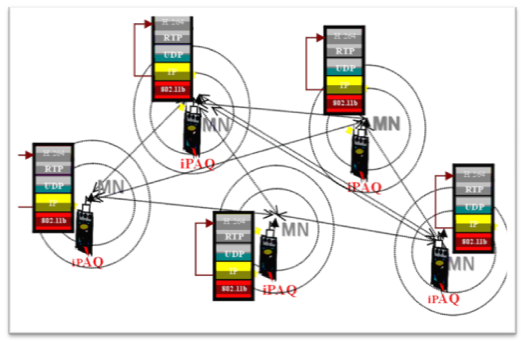OMNeT++ Ad Hoc Simulation
OMNeT++ Ad Hoc Projects AODV refereed as Ad Hoc On Demand Distance Vector routing protocol.Ad Hoc Network simulation projects is primarily used for MANET and other wireless networking projects.Main benefit of using Ad hoc Network using OMNeT++ Simulator it’s because of flexibility and adaptability.Ad Hoc is self configuring data network which does not require network infrastructure.
Advantages of ad hoc network:
- No expensive infrastructure must be installed.
- Use of licensed frequency spectrum.
- Quick distributions of information around sender.
Challenges on ad hoc network:
- Dynamic topology.
- Network functions must have high degree of adaptability.
- No central entities.
Applications of ad hoc network:
- Floating car data and car accident in vanet network
- In wireless sensor, detect vibrations, detect chemical substances, measure temperature etc.
- Biological sector
- Remote sensing in power plants
- Environmental monitoring.
Principle of ad hoc network:
- Multihop communication.
- Mobility adaptive operation.
- Self-organizing network without the need network infrastructure.
- Mobile device communicate in peer-to-peer fashion.
- Decentralized.
Download Sample Source Code for OMNeT++ AODV Routing Protocol
[code lang="js"]
void IdealChannelModelAdhoc::recalculateMaxTransmissionRange()
{
double newRange = 0.0;
for (RadioList::iterator it = radios.begin(); it != radios.end(); ++it)
{
IdealRadio *idealRadio = check_and_cast<IdealRadio *>(it->radioModule);
if (newRange < idealRadio->getTransmissionRange())
newRange = idealRadio->getTransmissionRange();
}
maxTransmissionRange = newRange;
}
void IdealChannelModelAdhoc::unregisterRadio(RadioEntry *r)
{
Enter_Method_Silent();
for (RadioList::iterator it = radios.begin(); it != radios.end(); ++it)
{
if (it->radioModule == r->radioModule)
{
// erase radio from registered radios
radios.erase(it);
maxTransmissionRange = -1.0; // invalidate the value
return;
}
}
error("unregisterRadio failed: no such radio");
}
IdealChannelModelAdhoc::RadioEntry *IdealChannelModelAdhoc::lookupRadio(cModule *radio)
{
for (RadioList::iterator it = radios.begin(); it != radios.end(); it++)
if (it->radioModule == radio)
return &(*it);
return NULL;
}
void IdealChannelModelAdhoc::setRadioPosition(RadioEntry *r, const Coord& pos)
{
r->pos = pos;
}
void IdealChannelModelAdhoc::initialize()
{
EV << "initializing IdealChannelModelAdhoc" << endl;
maxTransmissionRange = 0;
WATCH_LIST(radios);}
[/code]


